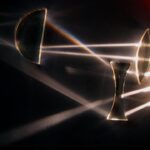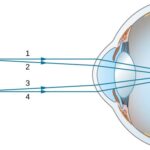One major principle discussed in both Unit 13 and Unit 14 of The Physics Classroom Tutorial is the line of sight principle:
In order to view an object, you must sight along a line at that object; and when you do light will come from that object to your eye along the line of sight.
This very principle is combined with rules of reflection and refraction in order to explain how an image is formed and what the characteristics of such images will be.
 Plane Mirror Image Formation
Plane Mirror Image Formation
In the plane mirror Lesson of Unit 13, it was mentioned that an image is formed by a plane mirror as light emanates from an object in a variety of directions. Some of this light reaches the mirror and reflects off the mirror according to the law of reflection. Each one of these rays of light can be extended backwards behind the mirror where they will all intersect at a point (the image point). Any person who is positioned along the line of one of these reflected rays can sight along the line and view the image – a representation of the object. Thus, an image location is a location in space where all the reflected light appears to come from. Since light from the object appears to diverge from this location, a person who sights along a line at this location will perceive a replica or likeness of the actual object. In the case of plane mirrors, the image is said to be a virtual image. Virtual images are images that are formed in locations where light does not actually reach. Light does not actually pass through the location on the other side of the plane mirror; it only appears to an observer as though the light were coming from this position.
Curved Mirror Image Formation
We have also seen how images are created by the reflection of light off curved mirrors. Suppose that a light bulb is placed in front of a concave mirror; the light bulb will emit light in a variety of directions, some of which will strike the mirror. Each individual ray of light will reflect according to the law of reflection. Upon reflecting, the light will converge at a point. At the point where the light from the object converges, a replica or likeness of the actual object is created; this replica is known as the image. Once the reflected light rays reached the image location, they begin to diverge. The point where all the reflected light rays converge is known as the image point. Not only is it the point where light rays converge, it is also the point where reflected light rays appear to an observer to be coming from. Regardless of the observer’s location, the observer will see a ray of light passing through the real image location. To view the image, the observer must line her sight up with the image location in order to see the image via the reflected light ray. The diagram below depicts several rays from the object reflecting from the mirror and converging at the image location. The reflected light rays then begin to diverge, with each one being capable of assisting an individual in viewing the image of the object.

For plane mirrors, virtual images are formed. Light does not actually pass through the virtual image location; it only appears to an observer as though the light was emanating from the virtual image location. The image formed by this concave mirror is a real image. When a real image is formed, it still appears to an observer as though light is diverging from the real image location. Only in the case of a real image, light is actually passing through the image location.
Converging Lens Image Formation
Converging lenses can produce both real and virtual images while diverging lenses can only produce virtual images. The process by which images are formed for lenses is the same as the process by which images are formed for plane and curved mirrors. Images are formed at locations where any observer is sighting as they view the image of the object through the lens. So if the path of several light rays through a lens is traced, each of these light rays will intersect at a point upon refraction through the lens. Each observer must sight in the direction of this point in order to view the image of the object. While different observers will sight along different lines of sight, each line of sight intersects at the image location. The diagram below shows several incident rays emanating from an object – a light bulb. Three of these incident rays correspond to our three strategic and predictable light rays. Each incident ray will refract through the lens and be detected by a different observer (represented by the eyes). The location where the refracted rays are intersecting is the image location.

In this case, the image is a real image since the light rays are actually passing through the image location. To each observer, it appears as though light is coming from this location.
Diverging Lens Image Formation
Diverging lenses create virtual images since the refracted rays do not actually converge to a point. In the case of a diverging lens, the image location is located on the object’s side of the lens where the refracted rays would intersect if extended backwards. Every observer would be sighting along a line in the direction of this image location in order to see the image of the object. As the observer sights along this line of sight, a refracted ray would come to the observer’s eye. This refracted ray originates at the object, and refracts through the lens. The diagram below shows several incident rays emanating from an object – a light bulb. Three of these incident rays correspond to our three strategic and predictable light rays. Each incident ray will refract through the lens and be detected by a different observer (represented by the eyes). The location where the refracted rays are intersecting is the image location. Since refracted light rays do not actually exist at the image location, the image is said to be a virtual image. It would only appear to an observer as though light were coming from this location to the observer’s eye.

Images of Objects That Do Not Occupy a Single Point
The above discussion relates to the formation of an image by a “point object” – in this case, a small light bulb. The same principles apply to objects that occupy more than one point in space. For example, a person occupies a multitude of points in space. As you sight at a person through a lens, light emanates from each individual point on that person in all directions. Some of this light reaches the lens and refracts. All the light that originates from one single point on the object will refract and intersect at one single point on the image. This is true for all points on the object; light from each point intersects to create an image of this point. The result is that a replica or likeness of the object is created as we sight at the object through the lens. This replica or likeness is the image of that object. This is depicted in the diagram below.

Now that we have discussed how an image is formed, we will turn our attention to the use of ray diagrams to predict the location and characteristics of images formed by converging and diverging lenses.


